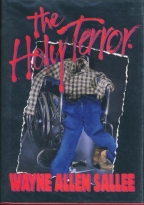The Holy Terror
Wayne Allen Sallee
Mark V. Ziesing
US Trade Hardcover
Publication Date: 1992
ISBN 0-929480-65-1
300 pages;$25.00
Date Reviewed: 10-16-1992
Reviewed by Rick Kleffel © 2002

REFERENCES
COLUMNS
|
|
|
The Holy TerrorWayne Allen SalleeMark V. ZiesingUS Trade HardcoverPublication Date: 1992ISBN 0-929480-65-1300 pages;$25.00Date Reviewed: 10-16-1992Reviewed by Rick Kleffel © 2002 |
|
|
REFERENCES |
COLUMNS |
From "The Fall of the House of Usher" to "The Haunting of Hill House", from "The Tell Tale Heart" to "The Hellbound Heart", horror has always been a genre whose characters and concerns are strictly middle class. In "The Holy Terror", Wayne Allen Sallee uses elements of surreal supernatural horror in a gritty urban setting to highlight the twisted denizens of Chicago's - or any city's - streets. Deftly combining repugnance and sympathy, Sallee creates ugly but enjoyable characters who achieve moments of profound reality as they move across Sallee's blighted cityscape. He does not threaten the inhabitants of any single building or milieu, but instead creates an almost Lovecraftian picture of a city whose streets could give birth to monsters and angels, whose back-alleys and byways are alive with humans of unimaginable stature and psyches.
Sallee's characters in "The Holy Terror" are like nothing we've seen since Flannery O'Conner sent Hazel Motes into the big city in her seminal novel "Wise Blood". Like O'Conner, Sallee has the talent to make his repulsive denizens of the street readable with an absurd sense of humor. Of course, he also has the talent to make them extremely terrifying, and in the first part of the novel, he spends a good deal of time doing just that. Still, Francis Haid is one of the most sympathetic serial killers we've seen since Hannibal Lecter, but not because he's witty. Sallee has created an unusual supernatural power, one that the reader will not forget, one that might make Haid as much of a savior as a murderer.
But it's the positive characters that give this novel its kick. Looking for Francis Haid are Victor Tremulis and Evan Shustak, two of the most peculiar and enjoyable characters to grace recent horror fiction. Victor Tremulis is an affirmed masochist who constantly tests his and the reader's mettle by indulging in painful pursuits. Despite his distasteful interests, he's really a nice, though obviously screwed-up guy. Don't be put off by his piercing and pulling - Vic turns out as OK as anyone in this novel does.
It's Evan Shustak, however, who is the novel's centerpiece. About a hundred pages into the novel, he dons his superhero outfit - wrist braces, a "utility belt" from which hang bags of vitamins and aspirin, and a plaid heating pad for a cape then announces: "Crippled and insane, I am the American Dream!" The American Dream is Sallee's greatest creation, a humorous, disturbed and very human haunter of Chicago's streets.
Sallee's novel has an unusual construction, one that may slow down some readers. He includes schizophrenic, paranoid and masochist points-of-view, along with journal entries by Vic Tremulis and The American Dream. But this just allows him to build a bulldozer force, and the ending will literally knock readers right off their feet. Chicago's streets are wonderfully rendered, and seemed real to this reader who never has - and with luck, never will - set foot upon them. The characters in this novel are people that you want to know more about. And the author of this novel is one we'll want to hear from again.